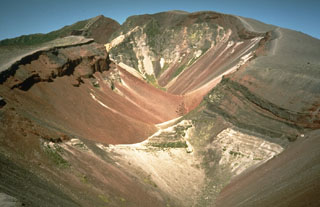Report on Okataina (New Zealand) — November 1987
Scientific Event Alert Network Bulletin, vol. 12, no. 11 (November 1987)
Managing Editor: Lindsay McClelland.
Okataina (New Zealand) Tectonic seismic swarm; no co-seismic deformation
Please cite this report as:
Global Volcanism Program, 1987. Report on Okataina (New Zealand) (McClelland, L., ed.). Scientific Event Alert Network Bulletin, 12:11. Smithsonian Institution. https://doi.org/10.5479/si.GVP.SEAN198711-241050
Okataina
New Zealand
38.1569°S, 176.5069°E; summit elev. 1111 m
All times are local (unless otherwise noted)
A short but intense sequence of earthquakes occurred in the Lake Rotomahana area of the [Tarawera] rift on 16 November. The largest event (ML 3.8) occurred at 1835, in the middle of the sequence; events continued until about 2000. A geodetic survey of the Lake Rotomahana strain monitoring pattern was completed ~20 minutes before the earthquake sequence commenced. Selected stations were reoccupied three days later but no significant co-seismic deformation was detected. All the earthquakes appeared to be of tectonic origin. Similar swarms were recorded 22-23 February 1986 and in February 1983.
The 17-km-long Tarawera Rift was the site of a vigorous eruption in 1886 that ejected ~0.7 km3 of basaltic magma in ~4 hours (Nairn and others, 1986); large phreatic explosions occurred from Lake Rotomahana, which has grown substantially since that eruption. Phreatic explosions have been recorded [16] times between 1896 and 1973 in the [Waimangu] thermal area to the SW, along the rift.
Reference. Nairn, I.A., Cole, J.W., Houghton, B.F., and Wilson, C.J.N., 1986, Tarawera 1886 eruption: International Volcanological Congress Handbook, 1-9 February 1986, p. 111-121.
Geological Summary. The massive, dominantly rhyolitic Okataina Volcanic Centre (OVC) is surrounded by extensive ignimbrite and pyroclastic sheets produced during multiple caldera-forming eruptions. Numerous lava domes and craters erupted from two subparallel NE-SW-trending vent lineations form the Haroharo and Tarawera volcanic complexes. Lava domes of the Haroharo complex, at the northern end of the OVC, occupy part of the 16 x 26 km Pleistocene Haroharo caldera, which formed incrementally between 300,000 and 50,000 years before present (BP). The oldest exposed rocks on the caldera floor are about 22,000 years old. The Tarawera complex at the southern end of OVC consists of 11 rhyolitic lava domes and associated lava flows. The oldest domes were formed as late as about 15,000 years BP, and the youngest were formed in the Kaharoa eruption about 800 years BP. The NE-SW Tarawera vent lineation extends from the two dacitic cones of Maungaongaonga and Mangakakaramea on the SW to Mount Edgecumbe on the NE. Construction of the Haroharo and Tarawera complexes impounded lakes Rotoiti, Totoehu, Okataina, and Tarawera against the outer margins of the Okataina ring structure. A major hydrothermal area is located at Waimangu; the world-renowned Pink and White Terrace siliceous sinter deposits were destroyed during the major basaltic explosive eruption of 1886.
Information Contacts: B. Scott, NZGS Rotorua; S. Sherburn, DSIR Geophysics, Wairakei.

